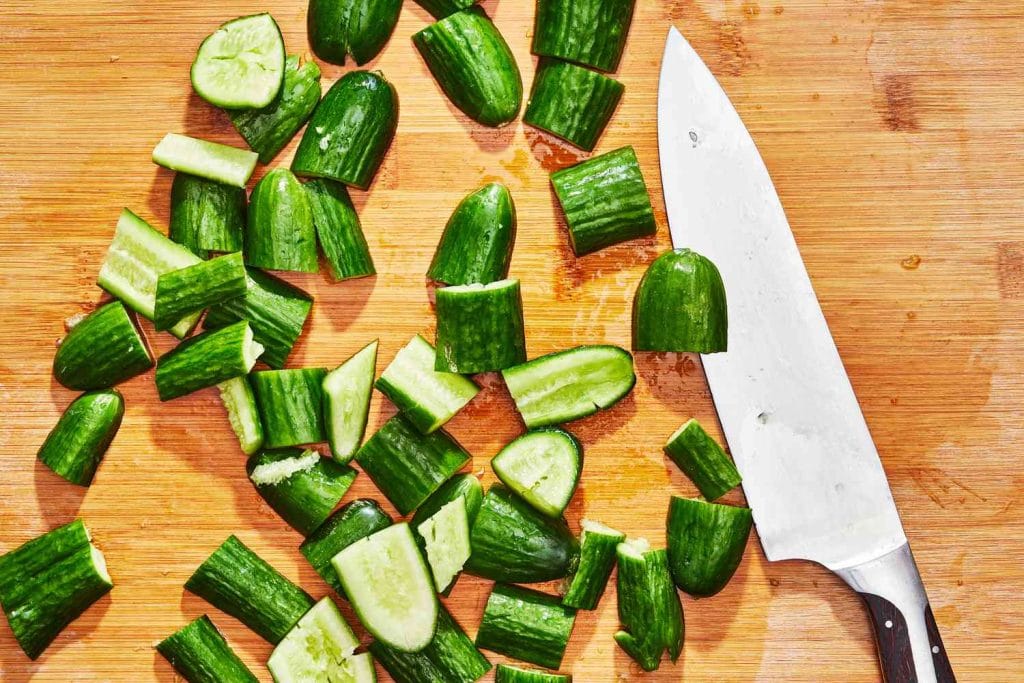
:max_bytes(150000):strip_icc():format(jpeg)/Smashed_Cucumber_Salad_004-6c1485c6af2645bf998f6c75a8116f9f.jpg)
Key Points
- Store cucumbers in a “sleeping bag,” or wrapped in paper towels and an opened bag to keep them fresh for up to a week.
- Cut cucumbers should be kept in an airtight container with a paper towel in the fridge and used within three days.
- Pickling, freezing, or dehydrating are great ways to preserve cucumbers, but toss them if they become slimy, soft, or start to smell off.
Cucumbers are a crisp, refreshing kitchen staple perfect for incorporating into salads, tea sandwiches, salsas, cocktails, sauces, pickles, and more. But while they’re crunchy and delicious when fresh, they can go soft or slimy pretty quickly if they aren’t stored properly.
With the right storage methods, you can extend the shelf life of cucumbers to enjoy them at their best for longer. Here’s how to store whole and cut cucumbers, how to spot signs of spoilage, and some of our favorite ways to use them up.
How To Choose The Best Cucumbers
When choosing fresh cucumbers at the supermarket, you’ll want to start by giving them a squeeze. Fresh cucumbers should be firm, without any soft or mushy spots, and feel heavy for their size. The skin should be smooth, without wrinkle or blemishes. Smaller cucumbers tend to remain crisp and fresh longer than oversized ones.
Note that unwaxed cucumbers from farmers’ markets or home gardens may have a shorter shelf life compared to waxed varieties at the grocery store.
How To Store Whole Cucumbers
Whole cucumbers are best stored in the refrigerator—ideally in the crisper drawer, where humidity is higher and the temperature is more stable. To keep them fresh longer, wrap whole cucumbers loosely in paper towels, and place into a perforated or open plastic bag for the best airflow. This method is sometimes called the “sleeping bag” technique. Avoid storing cucumbers near ethylene-producing fruits like apples or bananas, which can speed up spoilage.
When stored properly, whole cucumbers can last up to one week in the refrigerator.
Storing Cut Cucumbers
Once cucumbers are sliced or peeled, you’ll want to store them in an airtight container in the refrigerator. Place a paper towel into the container to help absorb moisture and maintain crispness, and enjoy the cucumbers within three days for the freshest texture and flavor.
Using refrigerator liners or mats, which have a perforated or textured finish, help promote good air circulation around your produce, reducing areas where moisture can collect.
Can You Freeze Cucumbers?
While cut cucumbers can be frozen, the texture may change after freezing and thawing. If you do have a bounty of freshly cut cucumbers that you can’t use in time, freeze the slices in a single layer on a lined baking sheet until firm, then transfer to a freezer-safe zip-top bag or airtight container to freeze for up to three months.
Frozen cucumbers are best used for smoothies, soups, or cooked dishes where a crisp texture isn’t vital.
Other Ways To Preserve Cucumbers
If you do want to preserve fresh cucumbers for later use, consider these methods:
- Pickling: Pickling is arguably the most popular way to extend the life of cucumbers. You can make quick pickles for short-term storage in the fridge, or use a water bath canning method for shelf-stable jars that last much longer.
- Dehydrating: Slice cucumbers thinly and dehydrate them to create crisp cucumber chips—a fun snack for the whole family.
- Relish or chutney: Transform cucumbers into a flavorful relish or chutney that can be stored in the refrigerator for short-term use or canned for long-term storage.
Signs of Spoilage
If you notice any of these signs of spoilage, it’s best to discard your cucumbers to avoid the risk of foodborne illness:
- Texture: Soft spots or mushy areas, or a slimy texture
- Appearance: Wrinkled, shriveled, or yellowing skin, or visible signs of mold
- Smell: A sour or off-smell
If stored properly, spoilage will be delayed, helping you make the most out of your cucumbers and reduce waste in the process.
Some Of Our Favorite Cucumber Recipes
Whether you love your cucumbers smashed, incorporated into cocktails or sauces, or stirred into dips, these classic recipes are some of our favorites:








